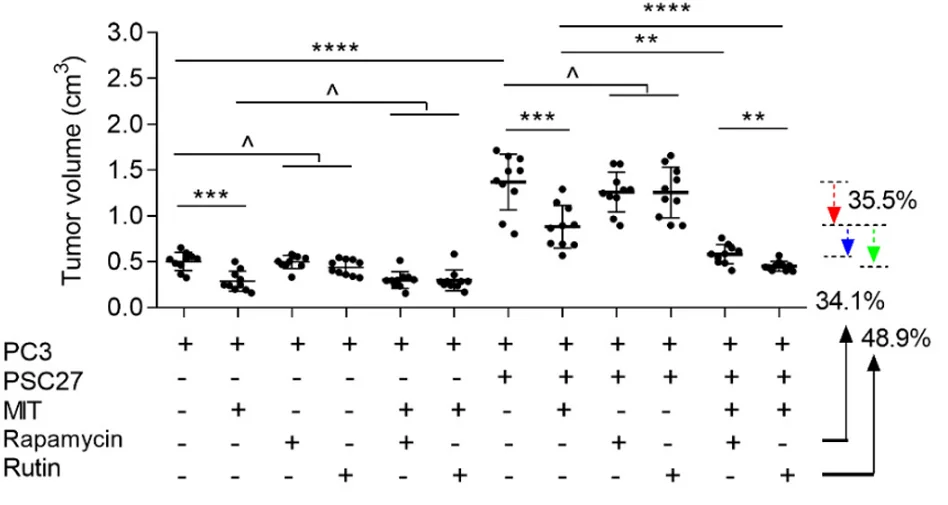Researchers publishing in Aging Cell have documented some potential effects of rutin against senescence and cancer. Rutin is a natural compound found in several plants.
Another compound to fight senescence
In this study, the researchers place rutin among the many other natural compounds that have demonstrated effectiveness in the lab against cellular senescence, including fisetin and quercetin. Rutin, a fat-soluble compound [1] that is also known as quercetin-3-O-rutinoside, has been found to have anti-inflammatory and antioxidant properties [2] and is produced by the well-known Ginkgo Biloba plant [3]. However, whether or not rutin does anything regarding senescent cells is a topic that has only been lightly explored.
Quelling the SASP, ASAP

Read More
For their experiments, the researchers chose a line of prostate stromal cells, PSC27, that was chemically driven senescent through administration of bleomycin. They then exposed these cells to 37 natural medicinal agents (NMAs) and observed the effects.
None of these NMAs were senolytic: they did not have the ability to destroy senescent cells. Rather, some of these agents showed signs of being senomorphic, which refers to their ability to suppress the effects of cellular senescence. Among the NMAs tested, rutin stood out in its ability to suppress the inflammatory factor interleukin 8 (IL-8).
Further testing revealed that rutin suppresses many other SASP factors as well, including other interleukins, CXCL3, and MMP3. An RNA analysis confirmed these results, showing that rutin had decreased the expression of these genes.
Interestingly, rutin did not decrease the amount of SA-ß-gal, a key biomarker of cellular senescence. The cells were just as senescent as they were before rutin administration; it was only the SASP that was suppressed.
The researchers also noted rutin’s effects against the acute stress-associated phenotype: the ASAP. Through multiple experiments and a process of elimination, they identified the specific biochemical pathway, finding that rutin prevents ASAP-activated ATM from activating HIF1a and TRAF6, two compounds that are key to the ASAP’s progression to the SASP.
Potential against cancer
The SASP has been documented to encourage malignancy in cancer cells [4]. Combining senescent prostate cells with prostate cancer cells confirmed these findings, showing that exposure to the SASP approximately doubled the invasiveness, cell number, and migration of multiple lines of prostate cancer cells. While rutin did nothing against cancer cells that had not been exposed to the SASP, combining rutin with the senescent and cancerous cells reduced the cancer’s proliferative abilities nearly to that of the SASP-unexposed cells.
With these findings in hand, the researchers then went to animal testing. Injecting combinations of cancer cells and other compounds into mice, the researchers found that, while still being effective, the chemotherapy drug MIT encourages cellular senescence and that the senescent PSC27 cells encourage tumor growth. Rapamycin was effective in blunting PSC27’s effects, but rutin was statistically even more effective.

Not a panacea but an addition
The researchers offer two potential uses for rutin. First, of course, is to quell the SASP in general, preventing out-of-control senescent cells from driving even more cells senescent, particularly in the context of aging. The second would be to include rutin in conventional chemotherapy treatments, limiting the SASP and the related cancer growth that such compounds can inadvertently promote. As always, clinical trials are necessary to determines if this works in people as well as mice.
Literature
[1] Negahdari, R., Bohlouli, S., Sharifi, S., Maleki Dizaj, S., Rahbar Saadat, Y., Khezri, K., … & Raeesi, S. (2021). Therapeutic benefits of rutin and its nanoformulations. Phytotherapy Research, 35(4), 1719-1738.
[2] Ghorbani, A. (2017). Mechanisms of antidiabetic effects of flavonoid rutin. Biomedicine & Pharmacotherapy, 96, 305-312.
[3] Morató, X., Marquié, M., Tartari, J. P., Lafuente, A., Abdelnour, C., Alegret, M., … & Boada, M. (2023). A randomized, open-label clinical trial in mild cognitive impairment with EGb 761 examining blood markers of inflammation and oxidative stress. Scientific Reports, 13(1), 5406.
[4] Chen, Q., Tang, L., Zhang, Y., Wan, C., Yu, X., Dong, Y., … & Huang, W. (2022). STING up-regulates VEGF expression in oxidative stress-induced senescence of retinal pigment epithelium via NF-?B/HIF-1a pathway. Life Sciences, 293, 120089.





